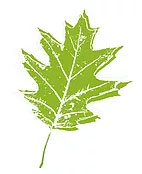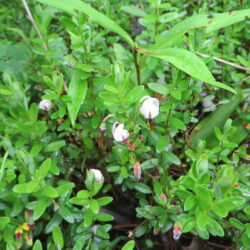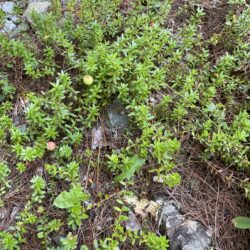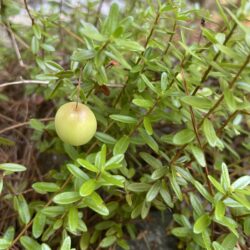Etymology
The name Vaccinium was used in classical Latin for a plant, possibly the bilberry or a hyacinth, and may be derived from the Latin bacca, meaning berry, although its ultimate derivation is obscure. Macrocarpon is Latin for large-fruited.
Native Habitat
Wet, peaty soils, and acidic bogs, but is also found growing in gravel roadsides. Requires soil with a pH < 6.8 (susceptible to chlorosis in alkaline settings).
Garden Uses
Large cranberry makes an excellent, edible ground cover in boggy areas, wet fields, water edges, and acidic areas. It can also thrive in well drained soil. Its sprawling habit should be considered before placement.
Overview
Mat-forming, trailing, low-growing evergreen shrub typically found in acidic, cool, boggy areas. Valued by humans and birds for its tart berry. Susceptible to a variety of diseases including root rot and fruit end rot, and to insects such as the cranberry weevil.
Leaves and Stems
Simple evergreen leaves are leathery and glossy, changing from bright green in summer to dark red to brown in winter. Yellowing indicates chlorosis due to alkalinity. Each leaf is < 1/4 inch in length, stalked, and grows one per node, alternately and overlapping on new growth. Stems are wiry, flexible, brown to gray, with several growing from one base and each growing up to 6 feet long.
Flowers
Self-pollinating. Small dangling bell-shaped flowers with four white to pink petals turned upward toward the stem and anthers protruding like a crane's beak, suggesting it's common name.
Fruit/Seed
Bright red to purple ovoid fruits grow as large as 1/2 inch and contain multiple tiny seeds. Fruit flesh is tart.
Wildlife Associates
Native bees pollinate; birds and possibly small mammals are attracted to fruits. Leaves feed larva of Bog Copper butterflies (Lycaena epixanthe).
Propagation
Commonly propagated by softwood cuttings in spring. Hardwood cuttings may root if unbranched. Stratify seeds for 60-90 days at 41 degrees F. Sow in acidic soil mix.
Ethnobotanical Uses
Very tart fruit is edible and often sweetened for baking and cooking. Commonly used in sauce, relish, and juice. Contains Vitamin C and antioxidants.
Garden Location
Patio Garden (see garden map)
Sources
Missouri Botanical Garden
Lady Bird Johnson Wildflower Center
Native Plant Trust
Hyam, R. & Pankhurst, R.J. (1995). Plants and their names : a concise dictionary. Oxford: Oxford University Press. ISBN 978-0-19-866189-4. p. 515.
Coombes, Allen J. (1994). Dictionary of Plant Names. London: Hamlyn Books. ISBN 978-0-600-58187-1. p. 187.
Plant Profile by Kate O’Dell



